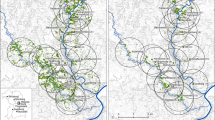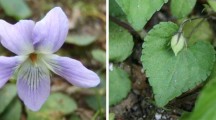Abstract
Context
Disturbances may affect the spatial patterns of plant genetic diversity, but these effects are not yet well understood for lack of direct experimental evidence. Grazing is one of such environmental disturbance factors which may lead to small-scale spatial heterogeneity in natural grasslands.
Objectives
Our main goal was to determine whether a grazing disturbance alters population genetic diversity and genetic structure of the dominant species in the Inner Mongolia Steppe.
Methods
We performed inter-simple sequence repeat (ISSR) molecular marker analysis on populations of Stipa grandis and S. krylovii which were exposed to five consecutive years of varying degrees of grazing disturbance.
Results
The amplification results showed that the genetic diversity of both S. grandis and S. krylovii populations varied under different grazing intensities; the highest diversity (Nei’s index and Shannon’s index) were under moderate disturbance, whereas the lowest under the heavy grazing. The coefficient of gene differentiation (GST) of S. grandis and S. krylovii populations were 16.82 and 21.00 °%, respectively. These results suggest that the genetic diversity of these two dominant populations was altered by the small-scale grazing disturbance, which provides new evidence supporting the theories of landscape genetics.
Conclusions
The enhancement of moderate grazing on genetic diversity implies the necessity to involve animal grazing in the design of management regimes for biodiversity conservation of the Inner Mongolia steppes.


Similar content being viewed by others
References
Anderson CD, Epperson BK, Fortin MJ, Holderegger R, James PM, Rosenberg MS, Scribner KT, Spear S (2010) Considering spatial and temporal scale in landscape-genetic studies of gene flow. Mol Ecol 19(17):3565–3575
Bai YF, Li DX, Xu ZX, Wei ZJ (1999) Growth and reproduction of Stipa krylovii population on a grazing gradient. Acta Ecol Sin 19(4):479–484
Balkenhol N, Gugerli F, Cushman SA, Waits LP, Coulon A, Arntzen J, Holderegger R, Wagner HH (2009) Identifying future research needs in landscape genetics: where to from here? Landscape Ecol 24(4):455–463
Banks SC, Cary GJ, Smith AL, Davies ID, Driscoll DA, Gill AM, Lindenmayer DB, Peakall R (2013) How does ecological disturbance influence genetic diversity? Trends Ecol Evol 28(11):670–679
Barrett BA, Kidwell KK (1998) AFLP-based genetic diversity assessment among wheat cultivars from the Pacific Northwest. Crop Sci 38(5):1261–1271
Bolliger J, Lander T, Balkenhol N (2014) Landscape genetics since 2003: status, challenges and future directions. Landscape Ecol 29(3):361–366
Boussaid M, Benito C, Harche M, Naranjo T, Zedek M (2010) Genetic variation in natural populations of Stipa tenacissima from Algeria. Biochem Genet 48(9–10):857–872
Bruggeman DJ, Wiegand T, FernÁNdez N (2010) The relative effects of habitat loss and fragmentation on population genetic variation in the red-cockaded woodpecker (Picoides borealis). Mol Ecol 19(17):3679–3691
Connell JH (1978) Diversity in tropical rain forests and coral reefs. Science 199(4335):1302–1310
Connell JH (1989) Some processes affecting the species composition in forest gaps. Ecology 70(3):560–562
Cushman S, Landguth E (2010) Scale dependent inference in landscape genetics. Landscape Ecol 25(6):967–979
Excoffier L, Smouse PE, Quattro JM (1992) Analysis of molecular variance inferred from metric distances among DNA haplotypes: application to human mitochondrial DNA restriction data. Genetics 131(2):479–491
Freedman AH, Thomassen HA, Buermann W, Smith TB (2010) Genomic signals of diversification along ecological gradients in a tropical lizard. Mol Ecol 19(17):3773–3788
Goldberg CS, Waits LP (2010) Comparative landscape genetics of two pond-breeding amphibian species in a highly modified agricultural landscape. Mol Ecol 19(17):3650–3663
Hamrick JL, Godt MJW (1990) Allozyme diversity in plant species. In: Brown AHD, Clegg MT, Kahler AL, Weir BS (eds) Plant population genetics, breeding, and genetic resources. Sinaeur Press, Sunderland, pp 43–63
Hirao AS, Kudo G (2004) Landscape genetics of alpine-snowbed plants: comparisons along geographic and snowmelt gradients. Heredity 93(3):290–298
Holderegger R, Wagner HH (2008) Landscape genetics. Bioscience 58(3):199–207
Holderegger R, Buehler D, Gugerli F, Manel S (2010) Landscape genetics of plants. Trends Plant Sci 15(12):675–683
Igawa T, Oumi S, Katsuren S, Sumida M (2013) Population structure and landscape genetics of two endangered frog species of genus Odorrana: different scenarios on two islands. Heredity 110(1):46–56
Inner Mongolia-Ningxia Integrative Expert Team of the Chinese Academy of Science (1985) Vegetation of Inner Mongolia. Science Press, Beijing
Jing Z, Yu J, Cheng J (2013) Genetic diversity of a dominant species Stipa bungeana and its conservation strategy in the Loess Plateau of China. Biochem Syst Ecol 47:126–131
Kimura M (1968) Evolutionary rate at the molecular level. Nature 217(5129):624–626
King JL, Jukes TH (1969) Non-Darwinian evolution. Science 164(3881):788–798
King LM, Schaal BA (1989) Ribosomal-DNA variation and distribution in Rudbeckia missouriensis. Evolution 43(5):1117–1119
Kleijn D, Steinger T (2002) Contrasting effects of grazing and hay cutting on the spatial and genetic population structure of veratrum album, an unpalatable, long-lived, clonal plant species. J Ecol 90(2):360–370
Li Y (1989) Impact of grazing on Aneurolepedium chinense steppe and Stipa grandis steppe. Acta Oecol/Oecol Appl 10(1):31–46
Li Y, Wang S (1999) Response of plant and plant community to different stocking rates. Grassl China 3:11–19
Linhart YB, Grant MC (1996) Evolutionary significance of local genetic differentiation in plants. Annu Rev Ecol Syst 27(1):237–277
Liu W, Wang X, Gan YM, Huang LK, Xie WG, Miao JM (2009a) Genetic diversity of Kobresia pygmaea populations along a Grazing gradient. J Plant Ecol 33(5):966–973
Liu WS, Dong M, Song ZP, Wei W (2009b) Genetic diversity pattern of Stipa purpurea populations in the hinterland of Qinghai-Tibet Plateau. Ann Appl Biol 154(1):57–65
Manel S, Holderegger R (2013) Ten years of landscape genetics. Trends Ecol Evol 28(10):614–621
Manel S, Schwartz MK, Luikart G, Taberlet P (2003) Landscape genetics: combining landscape ecology and population genetics. Trends Ecol Evol 18(4):189–197
Manel S, Gugerli F, Thuiller W, Alvarez N, Legendre P, Holderegger R, Gielly L, Taberlet P (2012) Broad-scale adaptive genetic variation in alpine plants is driven by temperature and precipitation. Mol Ecol 21(15):3729–3738
Matlaga D, Karoly K (2004) Long-term grazing effects on genetic variation in Idaho fescue. Rangel Ecol Manag 57(3):275–279
Mengli Z, Willms WD, Bing H, Laroche A (2005) Effects of heavy grazing pressure on the random amplified polymorphic DNA marker diversity of mountain rough fescue (Festuca campestris Rydb.) in south western Alberta. Can J Plant Sci 85(3):623–629
Murphy MA, Dezzani R, Pilliod DS, Storfer A (2010) Landscape genetics of high mountain frog metapopulations. Mol Ecol 19(17):3634–3649
Nei M (1972) Genetic distance between populations. Am Nat 106(949):283–292
Nei M (1973) Analysis of gene diversity in subdivided populations. Proc Natl Acad Sci 70(12):3321–3323
Nei M (1978) Estimation of average heterozygosity and genetic distance from a small number of individuals. Genetics 89(3):583–590
Nukazawa K, Kazama S, Watanabe K, Parmakelis A (2015) A hydrothermal simulation approach to modelling spatial patterns of adaptive genetic variation in four stream insects. J Biogeogr 42(1):103–113
Nybom H (2004) Comparison of different nuclear DNA markers for estimating intraspecific genetic diversity in plants. Mol Ecol 13(5):1143–1155
Phillipsen IC, Kirk EH, Bogan MT, Mims MC, Olden JD, Lytle DA (2015) Dispersal ability and habitat requirements determine landscape-level genetic patterns in desert aquatic insects. Mol Ecol 24(1):54–69
Rico Y, Holderegger R, Boehmer HJ, Wagner HH (2014) Directed dispersal by rotational shepherding supports landscape genetic connectivity in a calcareous grassland plant. Mol Ecol 23(4):832–842
Rohlf FJ (2000) NTSYSpc: numerical taxonomy and multivariate analysis system, Version 2.1. Setauket, New York
Rowe G, Beebee TJC, Burke T (1998) Phylogeography of the natterjack toad Bufo calamita in Britain: genetic differentiation of native and translocated populations. Mol Ecol 7(6):751–760
Schaal B, Hayworth D, Olsen K, Rauscher J, Smith W (1998) Phylogeographic studies in plants: problems and prospects. Mol Ecol 7(4):465–474
Shan D, Zhao M, Han B, Han G (2006) Examining the genetic diversity of Stipa grandis under various grazing pressures. Acta Ecol Sin 26(10):3175–3182
Slatkin M (1987) Gene flow and the geographic structure of natural populations. Science 236(4803):787–792
Slatkin M, Barton NH (1989) A comparison of three indirect methods for estimating average levels of gene flow. Evolution 43(7):1349–1368
Storfer A, Murphy M, Evans J, Goldberg C, Robinson S, Spear S, Dezzani R, Delmelle E, Vierling L, Waits L (2007) Putting the “landscape” in landscape genetics. Heredity 98(3):128–142
Wang W, Liang CZ, Liu ZL, Hao DY (2000) Analysis of the plant individual behaviour during the degradation and restoring succession in steppe community. Acta Phytoecol Sin 24(3):268–274
Wang J, Yang C, Yin J, Wang TJ (2004) Changes of the genetic diversity of Aremisia frigid population under the disturbance of grazing. Acta Ecol Sin 24:2465–2471
Wang JL, Zhao NX, Gao YB, Lin F, Ren AZ, Ruan WB, Chen L (2006) RAPD analysis of genetic diversity and population genetic structure of Stipa krylovii Reshov. in Inner Mongolia steppe. Russ J Genet 42(5):468–475
Wang L, Liu C, Alves DG, Frank DA, Wang D (2013) Plant diversity is associated with the amount and spatial structure of soil heterogeneity in meadow steppe of China. Landscape Ecol. doi:10.1007/s10980-013-9955-0
Wright S (1931) Evolution in Mendelian populations. Genetics 16(2):97–159
Wu J, Hobbs RJ (eds) (2006) Key topics in landscape ecology. Cambridge University Press, NewYork
Yeh FC, Yang R (1999) PopGene Version 1.32, Microsoft Windows-based freeware for population genetic analysis. University of Alberta, Alberta
Zancolli G, Rödel MO, Steffan-Dewenter I, Storfer A (2014) Comparative landscape genetics of two river frog species occurring at different elevations on Mount Kilimanjaro. Mol Ecol 23(20):4989–5002
Zhao NX, Gao YB, Wang JL, Ren AZ, Xu H (2006) RAPD diversity of Stipa grandis populations and its association with some ecological factors. Acta Ecol Sin 26(5):1312–1318
Acknowledgments
We thank Frank Yonghong Li (Inner Mongolia University) for assistance with constructive modification on the manuscript, and Christine Verhille (University of British Columbia) for improving the language. The research is funded by the National Key Basic Research Program of China (No. 2014CB138802), the National Key Technology R&D Program (No. 2013BAC09B03) and the National Natural Science Foundation of China (No. 31160476).
Compliance with Ethical Standards
Our study site was rental from local pastoral farmers, who gave permission to the grazing experiment. The field experiment did not involve any threatened animals and plants. The manuscript has not been submitted to other journals and never been published previously. The data are given in good faith. All co-authors are informed consent and declare no conflict of interest.
Author information
Authors and Affiliations
Corresponding author
Rights and permissions
About this article
Cite this article
Peng, J., Liang, C., Niu, Y. et al. Moderate grazing promotes genetic diversity of Stipa species in the Inner Mongolian steppe. Landscape Ecol 30, 1783–1794 (2015). https://doi.org/10.1007/s10980-015-0227-z
Received:
Accepted:
Published:
Issue Date:
DOI: https://doi.org/10.1007/s10980-015-0227-z




